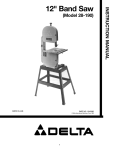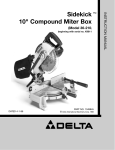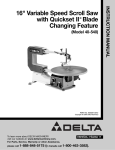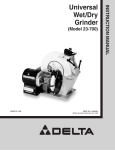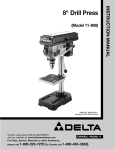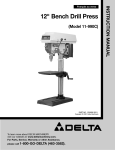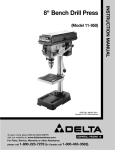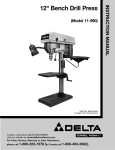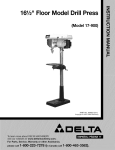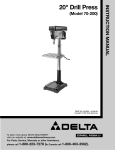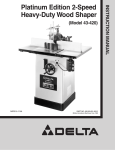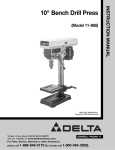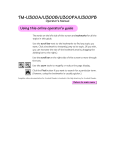Download Delta 14-070 Instruction manual
Transcript
MODEL 14-070 Dated 6-30-95 PART NO. 1046995 © Delta Machinery International Machinery Corp. 1995 INSTRUCTION MANUAL 14" Floor Drill Press TABLE OF CONTENTS SAFETY RULES 3 ADDITIONAL SAFETY RULES FOR DRILL PRESSES 4 UNPACKING 5 CLEANING 6 ASSEMBLY INSTRUCTIONS 6-9 FASTENING DRILL PRESS TO A SUPPORTING SURFACE 9 MOTOR SPECIFICATIONS AND ELECTRICAL REQUIREMENTS Motor Specifications 10 Power Connections 10 Extension Cords 10 Grounding Instructions 11 SPINDLE SPEEDS 12 CHANGING SPINDLE SPEEDS AND ADJUSTING BELT TENSION 13 SWITCH 14 LOCKING SWITCH IN THE “OFF” POSITION 14 TABLE ADJUSTMENTS 14-15 DRILLING HOLES TO DEPTH 16 ADJUSTING SPINDLE RETURN SPRING 16 OPERATION Correct Drilling Speeds 17 Boring In Wood 17 Drilling In Metal 17 WARRANTY SAFETY RULES Woodworking can be dangerous if safe and proper operating procedures are not followed. As with all machinery, there are certain hazards involved with the operation of the product. Using the machine with respect and caution will considerably lessen the possiblity of personal injury. However, if normal safety precautions are overlooked or ignored, personal injury to the operator may result. Safety equipment such as guards, push sticks, hold-downs, featherboards, goggles, dust masks and hearing protection can reduce your potential for injury. But even the best guard won’t make up for poor judgment, carelessness or inattention. Always use common sense and exercise caution in the workshop. If a procedure feels dangerous, don’t try it. Figure out an alternative procedure that feels safer. REMEMBER: Your personal safety is your responsibility. This machine was designed for certain applications only. Delta Machinery strongly recommends that this machine not be modified and/or used for any application other than that for which it was designed. If you have any questions relative to a particular application, DO NOT use the machine until you have first contacted Delta to determine if it can or should be performed on the product. DELTA INTERNATIONAL MACHINERY CORP. MANAGER OF TECHNICAL SERVICES 246 ALPHA DRIVE PITTSBURGH, PENNSYLVANIA 15238 (IN CANADA: 644 IMPERIAL ROAD, GUELPH, ONTARIO N1H 6M7) WARNING: FAILURE TO FOLLOW THESE RULES MAY RESULT IN SERIOUS PERSONAL INJURY 1. FOR YOUR OWN SAFETY, READ INSTRUCTION MANUAL BEFORE OPERATING THE TOOL. Learn the tool's application and limitations as well as the specific hazards peculiar to it. 2. KEEP GUARDS IN PLACE and in working order. 3. ALWAYS WEAR EYE PROTECTION. 4. GROUND ALL TOOLS. If tool is equipped with threeprong plug, it should be plugged into a three-hole electrical receptacle. If an adapter is used to accommodate a twoprong receptacle, the adapter lug must be attached to a known ground. Never remove the third prong. 5. REMOVE ADJUSTING KEYS AND WRENCHES. Form habit of checking to see that keys and adjusting wrenches are removed from tool before turning it “on.” 6. KEEP WORK AREA CLEAN. Cluttered areas and benches invite accidents. 7. DON'T USE IN DANGEROUS ENVIRONMENT. Don't use power tools in damp or wet locations, or expose them to rain. Keep work area well-lighted. 8. KEEP CHILDREN AND VISITORS AWAY. All children and visitors should be kept a safe distance from work area. 9. MAKE WORKSHOP CHILDPROOF - with padlocks, master switches, or by removing starter keys. 10. DON'T FORCE TOOL. It will do the job better and be safer at the rate for which it was designed. 11. USE RIGHT TOOL. Don't force tool or attachment to do a job for which it was not designed. 12. WEAR PROPER APPAREL. No loose clothing, gloves, neckties, rings, bracelets, or other jewelry to get caught in moving parts. Nonslip footwear is recommended. Wear protective hair covering to contain long hair. 13. ALWAYS USE SAFETY GLASSES. Wear safety glasses (must comply with ANSI Z87.1). Everyday eyeglasses only have impact resistant lenses; they are not safety glasses. Also use face or dust mask if cutting operation is dusty. 14. SECURE WORK. Use clamps or a vise to hold work when practical. It's safer than using your hand and frees both hands to operate tool. 15. DON'T OVERREACH. Keep proper footing and balance at all times. 16. MAINTAIN TOOLS IN TOP CONDITION. Keep tools sharp and clean for best and safest performance. Follow instructions for lubricating and changing accessories. 17. DISCONNECT TOOLS before servicing and when changing accessories such as blades, bits, cutters, etc. 18. USE RECOMMENDED ACCESSORIES. The use of accessories or attachments not recommended by Delta may cause hazards or risk of injury to persons. 19. REDUCE THE RISK OF UNINTENTIONAL STARTING. Make sure switch is in “OFF” position before plugging in power cord. 20. NEVER STAND ON TOOL. Serious injury could occur if the tool is tipped or if the cutting tool is accidentally contacted. 21. CHECK DAMAGED PARTS. Before further use of the tool, a guard or other part that is damaged should be carefully checked to ensure that it will operate properly and perform its intended function - check for alignment of moving parts, binding of moving parts, breakage of parts, mounting, and any other conditions that may affect its operation. A guard or other part that is damaged should be properly repaired or replaced. 22. DIRECTION OF FEED. Feed work into a blade or cuttter against the direction of rotation of the blade or cutter only. 23. NEVER LEAVE TOOL RUNNING UNATTENDED. TURN POWER OFF. Don't leave tool until it comes to a complete stop. 24. DRUGS, ALCOHOL, MEDICATION. Do not operate tool while under the influence of drugs, alcohol or any medication. 25. MAKE SURE TOOL IS DISCONNECTED FROM POWER SUPPLY while motor is being mounted, connected or reconnected. 26. WARNING: The dust generated by certain woods and wood products can be injurious to your health. Always operate machinery in well ventilated areas and provide for proper dust removal. Use wood dust collection systems whenever possible. ADDITIONAL SAFETY RULES FOR DRILL PRESSES 1. WARNING: DO NOT operate your drill press until it is completely assembled and installed according to the instructions. 2. IF YOU ARE NOT thoroughly familiar with the operation of drill presses, obtain advice from your supervisor, instructor or other qualified person. 3. YOUR DRILL PRESS MUST be securely fastened to a stand, workbench or floor. If there is any tendency for the stand or workbench to move during operation, the stand or workbench MUST be fastened to the floor. 4. NEVER turn the drill press “on” before clearing the table of all objects (tools, scrap pieces, etc.). 5. NEVER start the drill press with the drill bit or cutting tool in contact with the workpiece. 6. ALWAYS keep hands and fingers away from the drill bit or cutting tool. 14. NEVER perform layout, assembly or set-up work on the table while the drill is operating. 15. BE SURE drill bit or cutting tool is not damaged and is properly locked in the chuck before operating. 16. MAKE SURE chuck key is removed from chuck before starting drill press. ONLY use chuck key provided with your drill press. It is equipped with a self-ejecting pin which eliminates the hazard of the key being left in the chuck. 17. ADJUST the table or depth stop to avoid drilling into the table. 18. ALWAYS stop the drill press before removing scrap pieces from the table. 19. WHEN drilling large workpieces, MAKE SURE the material is supported at table height. 7. DO NOT ATTEMPT to drill material that does not have a flat surface, unless a suitable support is used. 20. SHUT OFF the power, remove the drill bit or cutting tool, and clean the table and work area before leaving the machine. 8. AVOID awkward hand positions where a sudden slip could cause a hand to move into the drill bit or cutting 21. WARNING: DO NOT wear gloves, necktie, or loose clothing when operating the drill press. tool. 9. TO PREVENT ROTATION OF THE WORKPIECE, ALWAYS clamp work securely to table if it is too short to contact the column (see “OPERATION” section of this manual) or when using hole saw or cutting tools larger than 1/2² in diameter. 22. SHOULD any part of your drill press be missing, damaged or fail in any way, or any electrical component fail to perform properly, shut off switch and remove plug from power supply outlet. Replace missing, damaged or failed parts before resuming operation. 12. WARNING: The use of accessories or attachments not recommended by Delta may result in risk of injury. 23. ADDITIONAL INFORMATION regarding the safe and proper operation of this product is available from the National Safety Council, 1121 Spring Lake Drive, Itasca, Illinois 60143-3201, in the Accident Prevention Manual for Industrial Operations and also in the Safety Data Sheets provided by the NSC. Please also refer to the American National Standards Institute ANSI 01.1 Safety Requirements for Woodworking Machinery and the U.S. Department of Labor OSHA 1910.212 and 1910.213 Regulations. 13. MAKE CERTAIN all lock handles are tightened before starting the machine. 24. SAVE THESE INSTRUCTIONS. Refer to them frequently and use them to instruct others. 10. WHENEVER POSSIBLE use clamps or vise to keep workpiece from rotating with the drill bit or cutting tool. 11. USE recommended speed for drill, accessory or workpiece material. UNPACKING Carefully unpack the drill press and all loose items from the carton. Figure 2 illustrates the drill press and all loose items supplied with the machine. WARNING: FOR YOUR OWN SAFETY, DO NOT CONNECT THE DRILL PRESS TO THE POWER SOURCE UNTIL THE MACHINE IS COMPLETELY ASSEMBLED AND YOU HAVE READ AND UNDERSTOOD THE ENTIRE INSTRUCTION MANUAL. Fig. 2 A - Head Assembly G - Base B - Column With Raising Rack Four Screws For Mounting Column C - Table H To Base D Mechanism Worm Gear For Table Raising And Lowering J - Three Allen Wrenches K - Three Pinion Shaft Handles E - Table Raising And Lowering Handle L - Chuck Key F - Table Locking Lever M - Chuck CLEANING Remove the protective coating from the machined surfaces of the drill press and all loose items. This coating may be removed with a soft cloth moistened with kerosene. DO NOT use acetone, gasoline, or lacquer thinner for this purpose. ASSEMBLY INSTRUCTIONS 1. Assemble the column (A) Fig. 3, to the base (B) using the four screws, three of which are shown at (C). 2. Loosen set screw in ring (D) Fig. 3, and remove ring (D) and raising rack (E). Fig. 3 3. Insert shaft of worm gear (F) Fig. 4, into hole (G) from inside of table bracket (H). Fig. 4 4. Insert raising rack (E) Fig. 5, which was removed in STEP 2, into groove in table bracket (H) making sure gear inside table bracket is engaged with teeth of raising rack. Fig. 5 5. Slide raising rack (E) Fig. 6, and table (J) onto drill press column, as shown. Make sure bottom of raising rack (E) is engaged with flange (K) on base of column. Fig. 6 6. Re-assemble ring (D) Fig. 7, which was removed in STEP 2 to column. IMPORTANT: Bottom of ring (D) MUST NOT be pushed all the way down onto top of raising rack (E). MAKE SURE top of raising rack (E) is under bottom of ring (D) and that there is enough clearance to allow rack (E) to rotate around the column without binding. Then tighten set screw (L) BEING CAREFUL NOT TO OVERTIGHTEN. Fig. 7 7. Assemble table raising and lowering handle (M) Fig. 8, to shaft on table bracket and tighten set screw in handle against flat on shaft. 8. Thread table bracket lock screw (O) Fig. 8, into hole in table bracket, as shown. Fig. 8 9. Place the drill press head onto the column as far as it will go. After the drill press spindle is aligned with the table and base, tighten the two set screws (P) Fig. 9. Fig. 9 10. Thread the three pinion shaft handles (R) Fig. 10, into the three tapped holes located in the pinion shaft hub,as shown. Fig. 10 11. IMPORTANT: Make certain the bottom of spindle (S) Fig. 11, and tapered hole (T) in chuck are clean and free of any grease, lacquer or rust preventive coatings. NOTE: Household oven cleaner can effectively remove any substance from the spindle and chuck; however, carefully follow the manufacturer’s safety rules concerning its use. Fig. 11 12. IMPORTANT: OPEN THE CHUCK JAWS AS WIDE AS POSSIBLE, MAKING SURE THE CHUCK JAWS ARE UP INSIDE CHUCK. 13. Hold chuck (U) Fig. 12, and carefully drive chuck onto the spindle with a block of wood and a hammer, or a mallet (V), as shown. This will seat the chuck properly on the spindle. IMPORTANT: To avoid damage to the chuck NEVER drive the chuck onto the spindle with a metal hammer. Fig. 12 FASTENING DRILL PRESS TO A SUPPORTING SURFACE PERMANENT MOUNTING If your drill press is to be used in one permanent location, the drill press base must be secured to the supporting surface with fasteners through the two mounting holes, (A) Fig. 12A, in the drill press base (B). Fig. 12A MOUNTING YOUR DRILL PRESS TO A PLYWOOD BASE If you do not fasten your drill press in a permanent manner, the drill press must be fastened to a plywood mounting board to prevent the drill press from tipping over during normal use. Use a good grade of plywood with a minimum 3/4" thickness. Do not make the mounting board from particle board since particle board can unexpectedly break. 1. Drill two 3/8" diameter holes (C) Fig. 12B, corresponding to the mounting holes (A) Fig. 12A, of the drill press base in a 21" by 28" minimum size plywood board (D) Fig. 12B. 2. Fasten the drill press base to the mounting board using the carriage bolts, nuts, and washers (E) Fig. 12B, furnished with your drill press. The carriage bolt heads must be countersunk such that the bolt heads are flush with the bottom surface of the mounting board in order to guarantee proper stability. 3. When the drill press is mounted to the supporting board, the board must extend a minimum of 3" beyond each edge of the drill press base, as shown in Fig. 12C. 4. The plywood base must be secured to the floor or supporting surface if there is any tendency of the drill press to vibrate, slide or walk during normal operation. Fig. 12B MOTOR SPECIFICATIONS AND ELECTRICAL REQUIREMENTS MOTOR SPECIFICATIONS Your drill press is designed to use a 1720 RPM motor. It is wired at the factory for 110-120 Volts, 60 Hz alternating current. Never use a motor that runs faster than 1720 RPM. power connections A separate grounded electrical circuit should be used for your drill press. This circuit should not be less than #12 wire and should be protected with a 20 amp fuse or circuit breaker. Before connecting the drill press to the power line, make sure the switch is in the “OFF” position. If the power cord is worn, cut or damaged in any way, have it replaced immediately by a certified electrician to avoid electrical shock or fire hazard. EXTENSION CORDS Use proper extension cords. Make sure your extension cord is in good condition. When using an extension cord, be sure to use one heavy enough to carry the current your product will draw. An undersized cord will cause a drop in line voltage resulting in loss of power and overheating. Fig. 12D, shows the correct gage to use depending on cord length and nameplate ampere rating. If in doubt, use the next heavier gage. The smaller the gage number, the heavier the cord. Fig. 12C TOTA LENGTH OF CORD IN FEET 0 26 51 101 - GAGE PF EXTENSION CORD TO USE 25 50 100 150 Fig. 12D 18 16 14 12 AWG AWG AWG AWG GROUNDING INSTRUCTIONS CAUTION: THIS TOOL MUST BE GROUNDED WHILE IN USE TO PROTECT THE OPERATOR FROM ELECTRIC SHOCK. In the event of a malfunction or breakdown, grounding provides a path of least resistance for electric current to reduce the risk of electric shock. This tool is equipped with an electric cord having an equipment-grounding conductor and a grounding plug. The plug must be plugged into a matching outlet that is properly installed and grounded in accordance with all local codes and ordinances. Do not modify the plug provided - if it will not fit the outlet, have the proper outlet installed by a qualified electrician. Improper connection of the equipment-grounding conductor can result in risk of electric shock. The conductor with insulation having an outer surface that is green with or without yellow stripes is the equipment-grounding conductor. If repair or replacement of the electric cord or plug is necessary, do not connect the equipment grounding conductor to a live terminal. Check with a qualified electrician or service personnel if the grounding instructions are not completely understood, or if in doubt as to whether the tool is properly grounded. Use only 3-wire extension cords that have 3-prong grounding type plugs and 3-hole receptacles that accept the tool's plug. Repair or replace damaged or worn cord immediately. GROUNDED OUTLET BOX 110-120 VOLT OPERATION As received, your drill press is ready-to-run for 110-120 volt operation. This drill press, when wired for 110-120 volts, is intended for use on a circuit that has an outlet and a plug that looks like the one shown in Fig. 13. A temporary adapter, which looks like the adapter illustrated in Fig. 14, may be used to connect this plug to a 2-pole receptacle, as shown in Fig. 14 if a properly grounded outlet is not avail-able. The temporary adapter should be used only until a properly grounded outlet can be installed by a qualified electrician. THIS ADAPTER IS NOT APPLICABLE IN CANADA. The green-colored rigid ear, lug, and the like, extending from the adapter must be connected to a permanent ground, such as a properly grounded outlet box, as shown in Fig. 14. CURRENT CARRYING PRONGS GROUNDING BLADE IS LONGEST OF THE 3 BLADES Fig. 13 HOLES GROUNDED OUTLET BOX GROUNDING MEANS 220-240 VOLT OPERATION Your drill press may be converted for 220-240 volt operation. The conversion of your drill press for 220-240 volt operation must be done by qualified electrical personnel. Should you desire to have your drill press converted for 220-240 volt operation take your drill press to your local Authorized Delta Service Center. You can phone 800-438-2486 for the location of the nearest Authorized Service Center. When converted for 220-240 volt operation, your drill press is intended for use on a circuit that has an outlet like the one illustrated in Fig. 14A. After conversion for 220-240 volts, the drill press will have a grounding plug that looks like the plug illustrated in Fig. 14A. Make sure the drill press is connected to an outlet having the same configuration as the plug. No adapter is available or should be used when the drill press is converted for 220-240 volts. If the drill press must be reconnected for use on a different type of electrical circuit, the reconnection should be made by qualified service personnel; and after reconnection, the tool should comply with all local codes and ordinances. HOLES ADAPTER Fig. 14 CURRENT-CARRYING PRONGS 230 VOLT GROUND PRONG Fig. 14A SPINDLE SPEEDS Twelve spindle speeds of 250, 360, 410, 540, 590, 650, 1090, 1280, 1450, 1820, 2180 and 3000 RPM are available with the 14" Drill Press. Fig. 15, illustrates which steps of the pulleys the belts must be placed to obtain the twelve speeds. Fig. 15 Fig. 16 CHANGING SPINDLE SPEEDS AND ADJUSTING BELT TENSION 1. DISCONNECT THE DRILL PRESS FROM THE POWER SOURCE. 2. Lift up belt and pulley guard (A) Fig. 16. 3. ing. Loosen tension lock knob (B) Fig. 16, along with the tension lock knob located on the other side of the head cast- 4. Release belt tension by moving tension lever (C) Fig. 16, forward. 5. Position the two belts (D) Fig. 16, on the desired steps of the motor, center and spindle pulleys. NOTE: A belt positioning chart (E) and a drill speed chart (F) is provided on the inside top cover of the drill press for your convenience. 6. After the belts are positioned on the desired steps of the motor, center and spindle pulleys, move tension lever (C) Fig. 16, to the rear until the belts are properly tensioned and tighten the two tension lock knobs, one of which is shown at (B). The belts should be just tight enough to prevent slipping. Excessive tension will reduce the life of the belts, pulleys and bearings. Correct tension is obtained when the belts (D) can be flexed about 1" out of line midway between the pulleys using light finger pressure. SWITCH The switch (A) Fig. 17, is located on the front of the drill press head. To turn the drill press “ON” move the switch to the up position. To turn the drill press “OFF” move the switch to the down position. Fig. 17 LOCKING SWITCH IN THE “OFF” POSITION We suggest that when the drill press is not in use, the switch be locked in the “OFF” position. This can be done by grasping the switch toggle (B) and pulling it out of the switch, as shown in Fig. 18. With the switch toggle (B) removed, the switch will not operate. However, should the switch toggle be removed while the drill press is operating, the switch can be turned “OFF” once, but cannot be restarted without inserting the switch toggle (B) Fig. 18. Fig. 18 TABLE ADJUSTMENTS 1. The table can be raised or lowered on the drill press column by loosening the table locking lever (A) Fig. 19, and turning the table raising and lowering handle (B). After the table is at the desired height, tighten locking lever (A). NOTE: Final positioning of the drill press table should always be from the bottom to the up position. 2. The table can be rotated 360 degrees on the column by loosening locking lever (A) Fig. 19, rotate table to desired position and tighten locking lever (A). Fig. 19 3. The table can be tilted right or left by pulling out and removing table alignment pin (C) Fig. 20, and loosening table locking bolt (D). NOTE: If pin (C) is difficult to remove, turn nut (E) clockwise to pull pin out of casting. Tilt table to the desired angle and tighten bolt (D). Fig. 20 4. When returning table to the level position, replace table alignment pin (C) Fig. 21. This will automatically position the table surface at 90 degrees to the spindle. Then tighten bolt (D). Fig. 21 5. A tilt scale (E) Fig. 22, is provided on the table bracket casting to indicate the degree of tilt. A witness line (F) is also provided on the table to line up with scale (E). Fig. 22 DRILLING HOLES TO DEPTH Where a number of holes are to be drilled to exactly the same depth, a depth stop is provided in the pinion shaft housing and is used as follows: 1. Loosen lock screw (A) Fig. 23, and rotate housing (B) until the pointer (C) lines up with the desired depth indicated on scale (D). Then tighten lock screw (A). 2. All holes will then be drilled to the exact depth as indicated on scale (D) Fig. 23. NOTE: Scale (D) is calibrated in both inches and metric. Fig. 23 ADJUSTING SPINDLE RETURN SPRING For the purpose of automatically returning the spindle upward after a hole has been drilled, a spindle return spring is provided in the spring housing (A) Fig. 24. This spring has been properly adjusted at the factory and should not be disturbed unless absolutely necessary. To adjust the return spring, proceed as follows: 1. DISCONNECT THE DRILL PRESS FROM THE POWER SOURCE. 2. Loosen the two nuts (B) Fig. 24, approximately 1/4". Do not remove nuts (B) from shaft (C). 3. While firmly holding spring housing (A) Fig. 25, pull out housing and rotate it until the boss (D) is engaged with the next notch on the housing. Turn the housing counterclockwise to increase and clockwise to decrease spring tension. Then tighten the two nuts (B) to hold the housing in place. Fig. 24 IMPORTANT: Inside nut (B) should not contact spring housing (A) when tight. Fig. 25 OPERATION Your drill press is to be used with drill bits of 5/8" or less in diameter. The following directions will give the inexperienced operator a start on common drill press operations. Use scrap material for practice to get a feel of the machine before attempting regular work. IMPORTANT: When the workpiece is long enough it should always be positioned on the table with one end against the column, as shown in Fig. 26. This prevents the workpiece from rotating with the drill bit or cutting tool, causing damage to the workpiece or personal injury to the operator. If it is not possible to support the workpiece against the column, the workpiece should always be fastened to thetable using clamps or a vise. Fig. 26 CORRECT DRILLING SPEEDS Factors which determine the best speed to use in any drill press operations are: kind of material being worked, size of hole, type of drill or other cutter, and quality of cut desired. The smaller the drill, the greater the required RPM. In soft materials, the speed should be higher than for hard metals. WARNING: Use the recommended speed for the drill press bit and workpiece material. As a guideline for the speed to use for different drill diameters and materials, refer to the chart located on the inside top cover of the drill press for your convenience. BORING IN WOOD Twist drills, although intended for metal drilling, may also be used for boring holes in wood. However, machine spur bits are generally preferred for working in wood; they cut a square bottom hole and are designed for removal of wood chips. Do not use hand bits which have a screw tip; at drill press speeds they turn into the wood so rapidly as to lift the work off the table and whirl it. For through boring, line up the table so that the bit will enter the center hole to avoid damage. Scribe a vertical line on the front of the column and a matchmark on the table bracket, so that the table can be clamped in the center position at any height. Feed slowly when the bit is about to cut through the wood to prevent splintering the bottom face. Use a scrap piece of wood for a base block under the work. This helps to reduce splintering and protects the point of the bit. DRILLING IN METAL Use clamps to hold the work when drilling in metal. The work should never be held in the bare hand; the lips of the drill may seize the work at any time, especially when breaking through the stock. If the piece is whirled out of the operator’s hand, he may be injured. In any case, the drill will be broken when the work strikes the column. The work must be clamped firmly while drilling; any tilting, twisting or shifting results not only in a rough hole, but also increases drill breakage. For flat work, lay the piece on a wooden base and clamp it firmly down against the table to prevent it from turning. If the piece is of irregular shape and cannot be laid flat on the table, it should be securely blocked and clamped. Two Year Limited Warranty Delta Machinery Delta will repair or replace, at its expense and at its option, any Delta machine, machine part, or machine accessory which in normal use has proven to be defective in workmanship or material, provided that the customer notifies his supplying distributor of the alleged defect within two years from the date of delivery to him, of the product and provides Delta Machinery with reasonable opportunity to verify the defect by inspection. Delta Machinery may require that electric motors be returned prepaid to the supplying distributor or authorized service center for inspection and repair or replacement. Delta Machinery will not be responsible for any asserted defect which has resulted from misuse, abuse or repair or alteration made or specifically authorized by anyone other than an authorized Delta service facility or representative. Under no circumstances will Delta Machinery be liable for incidental or consequential damages resulting from defective products. This warranty is Delta Machinery’s sole warranty and sets forth the customer’s exclusive remedy, with respect to defective products; all other warranties, express or implied, whether of merchantability, fitness for purpose, or otherwise, are expressly disclaimed by Delta.


















